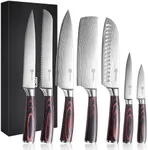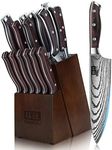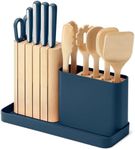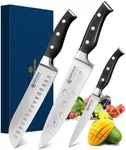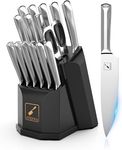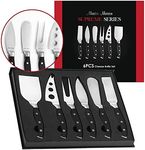Buying Guide for the Best Sharp Kitchen Knife Set
Choosing the right kitchen knife set is essential for any home cook or professional chef. A good set of knives can make food preparation easier, safer, and more enjoyable. When selecting a knife set, it's important to consider the types of knives included, the quality of the materials, and how comfortable they are to use. Here are some key specifications to help you make an informed decision.Blade MaterialThe blade material is crucial because it affects the knife's sharpness, durability, and ease of maintenance. Common materials include stainless steel, high-carbon stainless steel, and ceramic. Stainless steel is resistant to rust and easy to maintain, making it a good all-around choice. High-carbon stainless steel is harder and holds an edge longer but requires more care to prevent rust. Ceramic blades are extremely sharp and lightweight but can be brittle and prone to chipping. Choose a material based on your cooking habits and willingness to maintain the knives.
Handle MaterialThe handle material impacts the knife's comfort and grip. Common materials include wood, plastic, and composite. Wooden handles offer a traditional look and feel but require more maintenance to prevent cracking and warping. Plastic handles are durable and easy to clean but may not provide the best grip when wet. Composite handles combine the best of both worlds, offering durability and a good grip. Consider how the handle feels in your hand and how much maintenance you're willing to perform.
Knife Types IncludedA good knife set should include a variety of knives to handle different tasks. Common knives in a set include a chef's knife, paring knife, bread knife, utility knife, and sometimes a santoku knife. A chef's knife is versatile and can handle most tasks, while a paring knife is great for small, precise cuts. A bread knife has a serrated edge for slicing through crusty bread, and a utility knife is a smaller, all-purpose knife. Consider what types of food you prepare most often and ensure the set includes knives that will meet your needs.
Sharpness and Edge RetentionSharpness and edge retention determine how well the knife cuts and how often it needs to be sharpened. A sharper knife makes cleaner cuts and is safer to use because it requires less force. Edge retention refers to how long the knife stays sharp. High-carbon stainless steel and ceramic blades typically offer better edge retention than regular stainless steel. If you prefer not to sharpen your knives frequently, look for a set known for its long-lasting sharpness.
Balance and WeightThe balance and weight of a knife affect how comfortable it is to use. A well-balanced knife feels stable and easy to control, reducing hand fatigue during extended use. The weight of the knife is a personal preference; some people prefer heavier knives for their sturdiness, while others like lighter knives for their agility. Try holding different knives to see which balance and weight feel best in your hand.
Maintenance and CareConsider how much time and effort you're willing to put into maintaining your knives. Some materials and designs require more care, such as hand washing and regular sharpening, while others are more low-maintenance. Stainless steel knives are generally easier to care for than high-carbon steel or ceramic knives. If you prefer low-maintenance options, look for knives that are dishwasher safe and have good rust resistance.
Storage OptionsProper storage is important to keep your knives in good condition and ensure safety in the kitchen. Knife sets often come with a storage block, magnetic strip, or protective sheaths. A storage block keeps knives organized and easily accessible but takes up counter space. A magnetic strip can save space and display your knives, but it requires wall installation. Protective sheaths are great for drawer storage and protecting the blades. Choose a storage option that fits your kitchen layout and keeps your knives safe and accessible.
